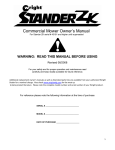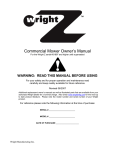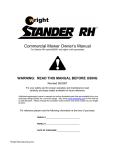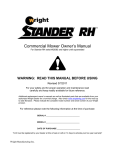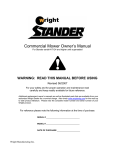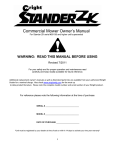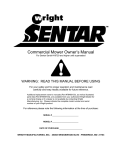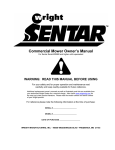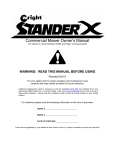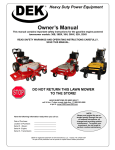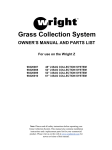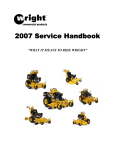Download Wright Velke V-TURN Owner`s manual
Transcript
V-TURN Commercial Mower Owner’s Manual WARNING: READ THIS MANUAL BEFORE USING For your safety and for proper operation and maintenance read carefully and keep readily available for future reference. Additional replacement owner’s manuals as well as illustrated parts lists are available from your authorized Wright Dealer for a nominal charge. Also check www.wrightmfg.com for the most up to date product literature. Please note the model number and serial number of your Wright product. For reference please note the following information at the time of purchase: SERIAL #: ______________________________ MODEL #: ______________________________ DATE OF PURCHASE: ____________________ WRIGHT MANUFACTURING, INC. 4600X WEDGEWOOD BLVD FREDERICK, MD 21703 Foreword Welcome to the progressive group of mowing professionals who use Wright mowers. We are focused on giving you advanced engineering and quality construction in each mower we build. This manual explains the features and promotes safer use of the mower. Please read it and follow the instructions carefully so you can have many years of productive mowing. For service, remember that your Wright dealer knows your mower best and is interested in your satisfaction. He can provide you with quality maintenance and other assistance you may need. Please give this manual to anyone who may use the mower for them to study before they operate it. Give the manual to anyone to whom you may sell the mower in the future. It is important for the next owner to receive this information also. As Wright Manufacturing, Inc. is constantly seeking ways to improve its products, the mower you have may differ slightly from the information and specifications in this manual. Because of our continuous product improvement, Wright reserves the option to make changes at any time without notice. Wright Manufacturing, Inc. SAFETY ALERT This is the safety alert symbol. It is used throughout this manual and on the mower’s safety labels to alert you to potential personal injury hazards. Obey all safety messages that follow this symbol to avoid possible injury or death. Read these instructions carefully. It is essential that you read the instructions and safety precautions before you attempt to work on or use this unit. WARNING This symbol with the word “WARNING” indicates a potentially hazardous situation which, if not avoided, could result in death or serious injury. CAUTION This symbol with the word “CAUTION” indicates a potentially hazardous situation which, if not avoided, may result in minor or moderate injury. ©2002 Wright Manufacturing, Inc. All rights reserved. This material may not be reproduced or copied, in whole or part, without written permission from Wright Manufacturing, Inc. Grass Gobbler, Gobbler, Leaf Gobbler, Turbo10, Velke, Pro 1, X2 and Velke Mower are trademarks of Wright Manufacturing, Inc. Table of Contents PRE-DELIVERY SERVICE OF MOWER BY DEALER .............................................................1 SAFETY INSTRUCTION MANUAL ...........................................................................................3 INTRODUCTION .................................................................................................................... 3 GENERAL SAFETY INSTRUCTIONS.................................................................................... 3 Owner/User Notice: ................................................................................................................3 User Experience and Qualifications: .......................................................................................3 User Clothing: ......................................................................................................................... 4 Inspect Mower Before Each Use: ........................................................................................... 4 Scheduled Mower Maintenance Safety: .................................................................................4 Work Area Conditions and Inspection:....................................................................................4 Initial Operating Safety Guidelines:.........................................................................................5 Operation on Slopes: ..............................................................................................................5 Replacement Parts: ................................................................................................................6 Operation in Reverse:.............................................................................................................6 Operation in Forward Direction: ..............................................................................................6 Operation During Zero-Radius Turns:..................................................................................... 7 Fuel Safety: ............................................................................................................................7 Hydraulic Safety:.....................................................................................................................7 OPERATING INSTRUCTIONS ..................................................................................................8 Inspect Mower Before Each Use: ...........................................................................................8 How to Start the Mower: ......................................................................................................... 8 How to Drive the Mower: ........................................................................................................8 V-Turn™ Technique............................................................................................................9 Velke Mower Controls – Straight.........................................................................................9 Velke Mower Controls – Right Turn ....................................................................................9 Velke Mower Controls – Left Turn.......................................................................................9 How to Stop and Park the Mower .........................................................................................10 How To Use The Mower On Varying Terrain........................................................................10 How to Change the Speed/Sensitivity Adjustment................................................................10 How to Perform the Tracking and Neutral Adjustment..........................................................10 How to Test/Use the Blade Clutch/Brake Switch ..................................................................11 How to Test the Operator Presence Control (OPC) Switch ..................................................11 Service and Adjustments ......................................................................................................11 Tire Maintenance and Pressure ........................................................................................11 Hydraulic Motor Support Adjustment.................................................................................11 Blade Adjustment and Height-of-Cut.................................................................................12 Belt Tension Adjustment ...................................................................................................12 How to Move the Mower If the Engine Won’t Start............................................................12 Bleeding Air from the Hydraulic System............................................................................12 Battery Service (if electric start) ........................................................................................13 Cleaning the Mower ..........................................................................................................13 Maintenance Schedule...........................................................................................................14 Maintenance Record ..............................................................................................................15 PRE-DELIVERY SERVICE OF MOWER BY DEALER WARNING If you are not completely familiar with the Safety Instruction Manual read it now before proceeding with the Pre-Delivery Service of the mower. Only your authorized Wright Mower dealer should perform the Pre-Delivery Service of the mower. The Wright Mower is shipped completely assembled and has been adjusted and tested at the factory. However, due to the jostling of the shipping process and the delivery time lapse, the following items need to be repeated again before starting the mower. After you have uncrated the mower, follow these procedures in the order indicated: • Remove spark plug wire from spark plug(s). • Inspect the mower for any damage, unusual conditions or missing parts. • Inspect the mower for all of its decals, especially the warning decals. There should be one blade warning decal on each side of the deck, the “shield missing” decal under the blade belt cover, and the dash decal. • Check to ensure belt guard is in place before operation. • Check (and fill if necessary) engine oil level according to the engine manufacturer’s recommendation. • Check (and fill if necessary) hydraulic fluid level. The level should be about 2-3” below the top of the oil fill. Use fully SYNTHETIC oil: Mobil-1 15W-50. • Check rear tire pressure. 8 to 12 psi. is recommended. It should be even on both sides. Use the higher pressures for heavier operators. Set the tire pressure in the front caster tires between 35 and 46 psi. Higher pressures will help keep the caster tires on their rims when impacted from the side but give a stiffer ride. Some Front Casters are equipped with non-pneumatic tires and do not required any air. • Remove the blade belt cover and check (and tighten if necessary) all belt tensions according to specifications further in this manual. DO NOT OVERTIGHTEN. • Rotate the blade pulleys slightly to see if they all turn together. (Note: Clutch Brake will create some resistance.) • Lubricate all moving parts (see Maintenance Items section of this manual). • Replace the blade belt cover. • Remove battery (if electric start version) from machine and fully charge (if necessary) in an open, well ventilated area according to the recommendations of the battery charger manual. The battery is 12 volts. After fully charged, install on mower and attach battery cables, positive first (from starter motor) and negative last (from ground). • Fill fuel tank with regular unleaded gasoline. Open fuel valve under gas tank. • DO NOT START THE ENGINE AT THIS TIME. FOLLOW THE NEXT PROCEDURE BEFORE STARTING. The hydraulic system MUST be checked for proper operation before allowing wheels to operate on the ground. • Set the rear of the machine on jack stands or blocks to raise rear wheels off the ground two or three inches and check to be sure that the mower will not fall off the supports you devise. The stand(s) must be able to secure the mower from rolling off or away during the next procedures. Check under the mower deck for any debris or unusual conditions. • With hand controls in the middle or neutral position, apply the parking brake. • Open the manual valves on top of each motor a half-of-a-turn counterclockwise. • Reattach spark plug wires to spark plugs. • Before starting the engine be ready to stop it if the wheels begin to turn with the brake on. (If this happens, check that the manual valves on top of each motor are open at least a half-of-a-turn counterclockwise.) 1 • Start the engine according to the engine manufacturer’s recommendation. Let the engine run at low RPM for several minutes to get the hydraulic fluid circulating through the pumps, etc. Release the parking brake. Now gradually close the manual bypass valves on top of each pump one at a time, and see if the wheels start to move. If the wheels move when the hand controls are in neutral position, adjust the neutral adjustment allen screw located on each pump until they stop. The manual valves on top of each pump should now be firmly closed. Now try moving the hand control levers, one at a time, forward and backward. Check to see if the wheels move forward and backward according to position of the levers. If not, service the hand control system. If the wheels stop when the hand controls are in the neutral position the parking brake should now be applied. Now check if the parking brake locking system (if applicable) prevents the unit from being driven while engaged. If not, service the parking brake locking system. • Before testing the blade clutch/brake operation, make sure the area is clear and there is nothing vulnerable to possible thrown objects from under the mower. No one should be near the mower deck or in its line of discharge at this or at any time. The discharge chute deflector should be in the down position. The parking brake should now be applied. Move the engine throttle to ¾ speed setting. • Turn on the blade clutch switch. Run blades for a minute or so. Try engaging and disengaging the blades a few times about 10 seconds apart. If the blades do not start and stop in a few seconds each time, service the blade brake system. With the blades on, now try disengaging the OPC switch to test the Operator Presence Control switch (OPC). The engine should die and the blades should stop in several seconds. If not, service the OPC system. Try this a couple of times. • Disengage the blades, set the parking brake, shut off the engine and remove the mower from the stand(s). • Drive the mower around on a level parking lot. It is recommended that the slower setting of the Speed/Sensitivity Adjustment be used. (See further in this manual for information on Speed/Sensitivity Adjustment.) Check that the mower drives in a straight line when both hand controls are held to the full speed position which is up against the stationary control bar. If not, see further in this manual for information on tracking adjustment. • As you drive the mower, listen for any unusual noises and test for irregular operation and adjust or service as necessary. Next, go over the safety information and operating procedures in this manual with the customer. Instruct the customer in proper operation and observe the customer during their initial operation on a level parking lot. Make sure the customer is familiar and comfortable with the basic operation and use of the mower. • Dealer: Please fill out and follow the instruction on the Product Registration Form and have the customer fill out his part of the form. After the Product Registration Card is filled out and signed by the customer and a representative from your dealership, please mail or fax it immediately (within 14 days from date of retail purchase) to your Wright Commercial Products Distributor according to the directions on the Card. Then give the customer his copy of the registration form and then keep your copy and mail the remaining copies of the form to your Wright Manufacturing Products Distributor. The limited warranty is not valid unless the mower is registered and all of the above steps are taken. Remember, the purchaser is both your and our customer and his satisfaction is very important. Thank you for supporting our products. • The mower is now ready for delivery to your customer. 2 SAFETY INSTRUCTION MANUAL WARNING This symbol with the word “WARNING” indicates a potentially hazardous situation which, if not avoided, could result in death or serious injury. WARNING TO WRIGHT MOWER USERS & OWNERS: READ THIS MANUAL BEFORE USING. PLEASE BE CAREFUL! INTRODUCTION The Velke Mower is built to the highest standards in the industry. However, carelessness or operator error may result in serious bodily injury or death. Accident and hazard prevention are dependent upon the awareness, concern, wisdom, and proper training of the personnel involved in the operation, transport, maintenance, and storage of the equipment. Make sure every operator is properly trained and thoroughly familiar with all of the information in this manual before operating the equipment. GENERAL SAFETY INSTRUCTIONS The Velke Mower is designed with your safety in mind. It has the following safety systems with which you should be familiar: • The warning decals on the mower including the instrument panel warning • The blade switch must be “off” before starting the engine • You must engage the OPC switch in order to engage the blades • You must engage the OPC switch in order for the engine to run if the blades are engaged • If the OPC switch becomes disengaged while the blades are running the engine will stop and the blades will brake in seconds • Letting go of the hand controls will stop the wheels instantly • Spring loaded chute deflector helps reduce trajectory of thrown objects • Belt/pulley covers on cutter deck and at rear under pump pulleys 3 CAUTION This symbol with the word “CAUTION” indicates a potentially hazardous situation which, if not avoided, could result in minor or moderate injury. WARNING Owner/User Notice: The owner’s/user’s obligation is to instruct themselves and all potential users in the safe operation of this equipment and be sure they read and follow the instructions in this safety manual and other material provided by Wright Manufacturing, Inc. before using or allowing others to operate the equipment. Do not operate this unit unless you carefully read, understand and follow the assembly, installation, and safety instructions contained in this manual and the warning decals provided on the unit. Do not allow other persons to use this unit unless you make sure they carefully read, understand and follow these instructions. Never allow children to operate or play on the unit. WARNING User Experience and Qualifications: This product is designed for use by physically fit, experienced, professional commercial mower operators who have a minimum of 160 hours of experience operating twelve horsepower and greater industrial mowers. Operators must be 18 years or older. They must have read and understood this manual. DO NOT allow children to operate the mower. Do not allow adults to operate the mower without proper instruction mentioned above. Never allow passengers on the mower. WARNING User Clothing: DO NOT operate the mower while wearing sandals, tennis shoes, sneakers or shorts. Always wear long non-baggy pants. Wear hightop leather work boots with thick, textured tread, soft-rubber soled at all times. Hard or smooth soled shoes are too slippery for a good footing the Velke™ or sulky. NEVER wear loose-fitting clothing which could get caught in moving parts or jacket pockets that can get caught to the handlebars or control levers of any mower you drive. Wearing safety glasses, ear protection and safety shoes is advisable and required by some local ordinances and insurance regulations. WARNING Inspect Mower Before Each Use: DO NOT use the mower if any parts are not maintained in good operating condition. Examine the moving parts prior to each use. Look for excessive wear, bald or worn tires, cracks in parts, loose or missing bolts, cotter, linchpin or “hair” pins or cable yoke pins and replace before operating the mower. Make sure all safety equipment provided with the mower is in good operating order, including all the warning decals and the required operator-presence device which stops the engine and blades when the handoperated Operator Presence Control (OPC) switch is released. (To test the OPC, follow instructions in the Operating Instructions section of this manual.) Be sure that all parts of the handoperated transmission control system are tight and secure. This is to reduce the possibility that the mower could have a loss of control or safety. WARNING Scheduled Mower Maintenance Safety: Replace worn tire(s) with less than 3/32” of any tread groove left. Use tires with the tread pattern specified by Wright Mfg., Inc. only. Grease all fittings daily. DO NOT change the engine governor settings or over-rev the engine contrary to engine manufacturer specifications. Keep the Wright mower in good operating condition, and keep safety devices and shields in place and in working condition. Keep all nuts, bolts, and screws tight to be sure the equipment is in safe working condition. Check the blade mounting bolts for proper tightness every eight (8) hours of operation. Check the blades for excessive wear and sharpness every four to eight (4-8) hours of operation. Replace excessively worn blades. Sharpen dull blades. The mower should not be used after the blades or other part of the mower strikes a foreign object, until conducting a thorough inspection and any damage is repaired. See the instructions in the Recommended Maintenance section of this manual for other items of required maintenance. WARNING Work Area Conditions and Inspection: Prior to operating the unit, carefully inspect all lawn/ground areas where you plan to use the mower for hidden, hard-to-see objects or uneven ground that may be hidden in the grass. Clear the work area of movable objects such as wires, rocks, glass, etc. that might be picked up by the mower and dangerously thrown. Remove, if possible, or mark the location of all immovable objects or irregular areas and be sure not to hit them with any part of the mower, its deck or the blades. Obstacles such as holes, abrupt changes in ground contour, tree trunks, stumps or roots, stub pipes protruding from the ground, paving edges, etc. in the path of operation can abruptly turn or stop the mower. This could throw you off the Velke™ or sulky or into and possibly over the handle bars causing serious injury or death. The faster you are moving the more potential there is for injury. Mow only in daylight or in good artificial light. Keep away from drop-offs, the edges of ponds, streams, pools, etc. especially at the bottom of slopes. Do not mow when children or others are around. When the Wright mower is in use, never direct the grass discharge toward bystanders, traffic, cars or buildings nor allow anyone near the machine while in operation. Thrown objects can pass through glass windows and some walls of buildings. There is extreme risk of danger from thrown objects or being cut by the blades of the mower or being run over if you lose control. Never operate the mower in an 4 enclosed area without good, approved ventilation. Exhaust fumes are dangerous. WARNING Initial Operating Safety Guidelines: • Read and understand the warning on the instrument panel of the mower. • Keep a firm hold on the stationary handle at all times. • Know the controls and how to stop quickly. • Before attempting to start the engine, follow all starting instructions below and in the engine operator’s manual. • Look behind before backing up and use extreme caution when backing up while standing on the Velke. • Before leaving the operator’s position, even momentarily, turn off the blade clutch engagement switch and apply the parking brake. Keep others from coming near the mower. Return to the operator position as soon as possible. • When leaving the Wright mower unattended, turn off the blade clutch engagement switch, apply the parking brake, stop the engine and remove the key. Never leave the machine unattended on a slope. If the parking brake becomes disengaged, the mower could roll which would be hazardous. • When transporting, driving onto transport vehicles, into buildings, across parking lots or otherwise not mowing grass, turn off the blade clutch engagement switch to reduce risk of thrown objects and rotating blade hazard. After coming to a stop, apply the parking brake, stop the engine and remove the key. • Before performing any maintenance or repair service, mowing height or other adjustments, disengage power to blades, apply the parking brake, stop the engine, remove ignition key and spark plug wire from spark plug(s). • DO NOT allow inexperienced people to operate the mower until they have read and understood these safety instructions. Operate the mower at slower speeds while becoming familiar with it. 5 • Speeding is dangerous for even an experienced operator. Sudden stops from excessive speeds may cause serious injury. • The grass discharge chute deflector must be installed at all times and in the down position except that it may be raised when the grass catcher is completely installed. • If the mower discharge clogs, turn off the blade clutch switch, apply the parking brakes, stop the engine and remove the key before removing obstruction. • Keep all shields and covers in place, especially grass discharge chute deflector, the blade belt cover, and the pump belt/pulley cover. • Keep hands, feet and clothing away from rotating parts, especially the rear wheels, blades, engine flywheel, belts and pulleys. • Do not touch engine or muffler while engine is running or soon after it is stopped. These areas can be so hot as to cause severe burns. • Clean grass, leaves and lubricant spills from surfaces after use to prevent fire hazard. • Be alert for traffic when crossing roads or operating near roadways. • Before crossing gravel drives, sidewalks or roads, turn off the blades and wait for them to stop. WARNING Operation on Slopes: DO NOT operate on steep slopes. Do not operate the mower on slopes steeper than you can feel secure about the traction of the tires and the stability of the mower. Do not operate the mower on slopes at all when the grass is wet. There is a danger of suddenly sliding sideways or down the hill. When operating on a slope, travel across the grade whenever possible, not in an up or down pattern. Reduce speed and exercise extreme caution on slopes and in sharp turns to prevent tipping or loss of control. Be especially cautious when changing direction on slopes. The Wright mower is capable of greater traction on slopes than typical riding mowers because of the benefits of a lower center of gravity. It is essential for you to know more about the handling characteristics of the mower so that you can enjoy more efficient mowing techniques and for increasing your safety. The Wright mower handles differently at different angles of attack on a slope. It is important to understand the following differences so that you can use or avoid using the mower at different angles for the best advantage. Be aware that if the following orientations to a slope and must handle the mower accordingly. As you use the mower you will gain the technique to mow more lawn than ever before. When pointing up a slope, the mower has the most weight on the drive wheels and therefore the most traction at the tires. However, this is the angle that it has the most tendency to tip back (“pop-a-wheelie.”) This is the preferred angle for mowing small areas of steeper slopes. Recommendations for this angle: • Do not accelerate quickly to avoid “popping-awheelie.” • If backing down the hill, do not stop suddenly but slow down gradually and maintain an upward force on the handles to keep the front of the mower on the ground. make it slip. This is the preferred angle for mowing large areas of gentle slopes. Recommendations for this angle: • Do not accelerate quickly to minimize the tendency of “popping-a- wheelie”. Accelerate gently. Note: Excessively worn tire tread is dangerous. Replace tire(s) with less than 3/32” of any tread groove left. Use tires with the tread pattern recommended by Wright Mfg., Inc. only. Keep the tire pressure in the drive tires at the recommended level. Higher pressures will cause the tires to have less traction which will force you to go slower and with less safety. Replacement Parts: Use of parts other than specified parts supplied by Wright Manufacturing, Inc. may compromise the safe use of the mower and are not recommended. WARNING Operation in Reverse: When pointing down a slope, the mower has the least weight on the drive wheels and therefore the least traction at the tires. This is the angle that the mower has the most tendency to slide. However, this is the angle that it has the least tendency to tip back. Avoid this angle, as it has the least advantage for the mower. Recommendations for this angle: • Do not change speed suddenly to minimize the tendency of going into a slide. Accelerate and slow down gently. If you ever go into an uncontrolled slide while pointing down a slope, the recommended procedure is to let go of the handles and move up-hill from the mower. Otherwise, control the mower gently and stay off slopes that tend to make the wheels slide at this orientation. When crossing a slope sideways, the mower has the average amount of weight on the drive wheels versus the front wheels, similar to level ground. However, this angle leaves the least weight on the higher side drive wheel, tending to Use extreme caution when operating in reverse while standing on the Velke. Always keep a firm grip on the mower handles with both hands. Operate the mower very slowly, inching it backward until you become familiar with how the mower operates. Always operate slowly if in an awkward location or position. While backing up never place your foot or feet on the ground near the back edge of the mower to prevent serious personal injury if mower were to run over you. Look behind you before backing to prevent injuring yourself or anyone behind you. Operate at slow speeds in forward and reverse if not completely familiar with mower operation. See the “How to change the Speed/Sensitivity Adjustment” section of this manual. WARNING Operation in Forward Direction: Always keep a firm grip on the mower handles with both hands. Operate the mower slowly until 6 you become familiar with how the mower operates. Do not operate the mower faster than conditions allow. For example, hills, wet or bumpy ground, dim light or high grass would all be conditions where you should work slower than normal. Never operate the mower at the highest speed unless you are on level, wide, open areas of clearly visible ground or transporting on paved areas. Speeding with any mower is dangerous, and so is traveling faster than conditions should permit on this mower. Sudden stops from excessive speed or becoming detached from the mower may cause serious injury or death. See the “How to change the Speed/Sensitivity Adjustment” section of this manual. WARNING Operation During Zero-Radius Turns: During zero-radius turns (when one mower wheel rotates backwards while the other is moving forward) drive extra slowly to reduce the possibility of losing traction, or control, or becoming dizzy. This will help prevent you from losing control of the mower. Be aware that if you do a turn on a slope you may go through all of the orientations to a slope mentioned above and must handle the mower accordingly. WARNING Fuel Safety: Handle gasoline with care – it is HIGHLY FLAMMABLE. Do not smoke while handling gasoline. Use an approved gasoline container. Never remove the fuel cap or add gasoline to a running or hot engine or an engine that has not been allowed to cool for several minutes after running. Never fill the tank indoors and always clean up spilled gas. NEVER store the equipment with gasoline in the tank inside a building where fumes may reach an open flame or spark. Allow the engine to cool before storing in any enclosure. 7 WARNING Hydraulic Safety: Keep body and hands away from pin holes or fittings that eject hydraulic fluid under high pressure. Use paper or cardboard and not hands to search for leaks. Hydraulic fluid escaping under high pressure may have sufficient force to penetrate skin and cause serious injury. If foreign fluid is injected into the skin, it must be surgically removed within a few hours by a doctor familiar with this form of injury or gangrene may result. Seek medical attention immediately. Make sure all hydraulic fluid connections are tight and all hydraulic hoses and lines are in good condition before starting the Wright mower. Hydraulic fluid is under high pressure. If you need service on your hydraulic system, please see your authorized Wright dealer. We really want you to be as safe as possible. Please read the above again and again until you fully understand the methods to promote the safest operation possible. REMEMBER – YOUR MOWER CAN BE ONLY AS SAFE AS THE OPERATOR. FAILURE TO FOLLOW SAFE OPERATING PRACTICES MAY RESULT IN SERIOUS INJURY OR DEATH. OPERATING INSTRUCTIONS WARNING If you are not completely familiar with the Safety Instruction Manual, read it now before proceeding with the operation of the mower. REMEMBER THERE ARE CERTAIN PRECAUTIONS LISTED IN THIS MANUAL THAT YOU MUST NOW TAKE BEFORE STARTING THE MOWER. Inspect Mower Before Each Use: Inspection of Mower: Do not use the mower if any parts are not maintained in good operating condition. Examine all moving parts prior to each use. Look for excessive wear, bald drive tires or worn out front tires (normally smooth), cracks in parts, loose or missing bolts, cotter, linchpin or “hair” pins and replace before operating the mower. Make sure all safety equipment provided with the mower is in good operating order, including all warning decals and the operatorpresence device which stops the engine and blades when the hand-operated Operator Presence Control (OPC) switch is released. To test the OPC, follow the instructions further down in this manual. Ensure that all parts of the handoperated transmission control system are tight and secure. This is to reduce the possibility that the mower could have a loss of control or safety. Basic Operation: The following procedures are to guide you through the basic operation of the mower. You should be a qualified mower operator according to the safety section of this manual. If this is your first time, operation should only be done with the assistance of your dealer on a level area. You should go through each step, in the order indicated, every time you start the mower. to the engine manufacturer’s recommendation, see engine manual, keeping in mind that various models use different choke controls. Electric Start: • Start the engine according to the engine manufacturer’s recommendation (see engine manual). You will need to start the engine by turning the key on the mower’s instrument panel. Do not engage the starter for more than ten (10) seconds at a time. This may overheat the starter and the wiring systems. Wait ten (10) seconds between attempts. If the engine does not start within ten tries or stalls frequently, take the mower in for service. After starting the engine according to the engine manufacturer’s recommendation, let the engine run for several minutes to get the hydraulic fluid circulating through the pumps, etc. and to allow the engine to warm up. Do not over-rev a cold engine. Unusual Noises or Irregular Operation As you drive the mower listen for any unusual noises and test for irregular operation and adjust or service as necessary. How to Drive the Mower: How to Start the Mower: Before starting the engine • Make sure the control levers are in the exact neutral position • Apply the parking brake if it is not already set. • Turn OFF the blade engaging switch if it is on. Starting the engine Recoil Start: • Turn the ignition key to the “Run” position • Check to see if the equipment has a separate choke knob or whether it is incorporated into the throttle control. Start the engine according Increase the engine speed about one fourth of the way from idle. Release the parking brake. Now try moving the hand control levers, one at a time, very slightly, forward and backward. Check to see if the wheels move forward and backward according to the position of the levers. (If not, service the hand control system.) If the wheels stop when the hand controls are in the neutral position the parking brake should now be applied. Now check if the parking brake locking system (if applicable) prevents the unit from being driven. (If not, service the parking brake locking system.) Increase the engine speed to about half of the way from idle speed. Release the parking brake. 8 The higher engine speed will make the controls much more responsive and the mower much quicker; Use with caution. Now try moving the hand control levers, one at a time, very slightly, forward and backward. Gradually increase your speed until you are well acquainted with the operation of the hand controls and the mower’s behavior. After gaining a good feel for how the mower handles, gradually attempt higher engine speeds until familiar with operation at full throttle engine speed. forward with your four fingers. As the mower’s direction straightens out roll your hand naturally back to the normal position and begin again to hold pressure on the control lever with your thumb as before the turn began. For a video demonstration, please go to www.wrightmfg.com. Velke Mower Controls – Straight V-Turn™ Technique This is a unique method only possible with the Wright Velke mower. You already know how to do a U-turn – but now there’s the V-turn™. After a few minutes of practice, the V-turning™ will let you take smoother, quicker turns, while standing up straighter, feeling more comfortable, making smooth maneuvers. V-turning™ especially works well with one or two-wheeled Velke™ sulkies. Caution: be sure that you have no baggy, loose clothing or jacket pockets that can get caught to the handlebars or control levers of any mower you drive. Velke Mower Controls – Right Turn How to V-turn™. Begin to learn by gradually slowing the mower so the turn will be slow, then: • • • • 9 Gradually let off the forward pressure of your thumb on the control lever on the inside of the turn you want to take. You will maintain pressure on the outside control lever at the speed of the turn you desire. Since the outside handlebar is now angled toward you, your outside hand and arm will be comfortably positioned during the turn. Completely allow your inside thumb to let go of the control lever and roll your inside hand forward and around the front of the handlebar. While keeping your thumb hooked on the handle bar get your four fingers ready to squeeze the control lever from underneath the handlebar (see picture). To trace a small circle with the inside wheel to protect the turf, slightly squeeze the inside control lever with your four fingers from underneath. With this new orientation of your forearm, the inside handlebar is angled toward you so your inside hand will be comfortably positioned during the turn. When nearing the end of your desired turn, just further squeeze the inside control levers Velke Mower Controls – Left Turn How to Stop and Park the Mower Come to a complete stop. If the blades are on, turn them off using the switch on the instrument panel. Make sure the control levers are in the exact neutral position. Set the parking brake, reduce the engine speed to idle, shut off the ignition switch to stop the engine and then remove the key from the ignition switch. The mower is now parked. Do not leave unit parked unattended without engaging the parking brake and do not leave the unit parked unattended on a sloped surface. How to Drive the Mower Over a Curb To climb a curb, first see the Safety Instruction Manual section of this manual, especially the parts on: • Initial Operating Safety Guidelines • Operation In Reverse • Operation In Forward Direction To drive over and up a curb proceed forward to the curb, lift the front wheels off the ground by pushing down on the handlebar and move slowly forward allowing the front wheels to rest on the ground beyond the curb. Then proceed slowly while driving the rear wheels over the curb. To drive over and down a curb proceed slowly forward to the curb and allow the front wheels to slowly roll off of the curb and down to the ground below the curb. Then move slowly forward until the rear wheels roll over the curb and down to the ground below. NEVER stand on the Velke (sulky) while driving over a curb. How To Use The Mower On Varying Terrain See the Safety Instruction Manual section of this manual, especially the parts on: • Initial Operating Safety Guidelines • Operation On Slopes • Operation In Reverse • Operation In Forward Direction • Operation During Zero-Radius Turns WARNING How to Change the Speed/Sensitivity Adjustment The controls are initially set with the Speed/ Sensitivity Adjustment in the faster, more sensitive position. The adjustment can be changed to the slower setting. This will increase the ground speed approximately 25-30%. The slower setting has a corresponding decrease in the sensitivity of the controls. In other words, a given amount of movement of the control levers will cause about a 25-30% change in the ground speed making the controls more sensitive. After stopping the engine, the adjustment is made by removing the control rods from the current holes in the control levers and reinstalling them in the alternate holes. The holes closest to the control handle pivot bushings (toward the back of the mower) are for this slower, less sensitive setting and the holes farthest from the pivot bushings are the faster, more sensitive setting. BE SURE THE BOLT/NUT IN THE CONTROL ROD ENDS ARE SECURELY REPLACED EACH TIME YOU REMOVE THEM. You must then perform the Tracking Adjustment, further described below. How to Perform the Tracking and Neutral Adjustment First ensure that the tire pressure is equal on both rear drive tires. Drive the mower on a level parking lot with engine at full throttle. Check that the mower drives in a straight line when both hand controls are held to the full speed position. If not, park the mower and stop the engine. The adjustment is made by removing the control rod from one or the other of the swivel ends at the lower ends of the control rods and screwing the swivel to either make the control rod longer or shorter. The turnbuckle may also be used for this adjustment. Before changing the length of the rods several facts are important to know. In the “faster” Speed/Sensitivity setting neither rod should be lengthened so much that at full speed it pulls the pump control lever (on the sides of the pumps) against the pump stop. Therefore, to reach the maximum capable speed, the rods should be lengthened one turn at a time until you can feel in the hand control that the pump stop has been contacted. Then shorten the rod one turn. You will feel the slight resistance. There is no need to start the engine or even replace the hair pin while checking this incrementally. Just put the swivel in the hole in the lever and test it by 10 squeezing the handle to full fast position. Remember, this procedure does not apply if the Speed/Sensitivity Adjustment is in the slower setting. Otherwise you will wind the swivels way up the rods and the mower will go faster but will lose most or all of its reverse capability and then the gap between the handlebar and the control levers becomes excessive when at the neutral position. If the rod is made longer it will speed up that side of the mower and if the rod is made shorter it will slow down that side of the mower. So, if the mower is tracking to the left, either the left side needs to go faster (by lengthening the rod) or the right side needs to go slower (by shortening the rod). If the mower is tracking to the right, either the right side needs to go faster (by lengthening the rod) or the left side needs to go slower (by shortening the rod). It is important that neither rod should be lengthened too far, as mentioned above. The only reference point to limit the adjustment from becoming extremely off is the relative position of the pump stop and the handlebar in the faster Speed/Sensitivity setting. Therefore, if everything is way off either because you are installing new parts (or other reasons) you should only use the faster Speed/ Sensitivity setting to get the tracking accurate and then change to the slower speed range and adjust the tracking only one or two turns on either side. BE SURE THE BOLT/NUT IN THE CONTROL ROD IS SECURELY REPLACED EACH TIME YOU REMOVE THEM. After getting the mower to track straight, readjust the neutral adjustment on the pump by using a ¼” allen wrench at the Return-to-Neutral (RTN) mechanism, if necessary. It is normal to make these adjustments from time to time. How to Test/Use the Blade Clutch/Brake Switch Before testing the blade clutch/brake operation, make sure the area is clear and there is nothing vulnerable to thrown objects from under the mower. No one should be near the mower deck or in its line of discharge. The discharge chute deflector should be in the down position. The parking brake should now be applied. Move the engine throttle to ¾ speed setting. (When mowing, the engine speed should always be at its highest setting. The engine governor will regulate 11 the engine according to the different mowing conditions at that setting.) Engage the OPC switch and turn on the blade clutch switch. Run blades for a minute or so. Try engaging and disengaging the blades a few times about 10 seconds apart. If the blades do not start and stop in a few seconds each time, service the blade brake system or contact your local Wright dealer. Under mowing load, the clutch’s longevity will be the greatest at the highest RPM setting. How to Test the Operator Presence Control (OPC) Switch With the parking brake applied, engage the OPC switch on the Handle Bar. This action should kill the engine. With the parking brake OFF and with the blades ON, disengage the OPC switch. The engine should kill and the blades should stop within a few seconds. If not, service the OPC system. WARNING Service and Adjustments Tire Maintenance and Pressure Excessively worn tire tread is dangerous on all hills. Replace drive tires with less than 3/32” of any tread groove left. Use tires with the tread pattern recommended by Wright Mfg., Inc. only. Keep the tire pressure at the proper level. Higher pressures will cause the tires to have less traction which will force you to go slower, with less safety and give you a harder ride. Higher pressures will help keep the front caster tires on their rims when impacted from the side but give a harder ride. They do not have any tread but should be replaced when excessively worn. Hydraulic Motor Support Adjustment The various holes in the mower frame and the hydraulic motor supports may be used to make a fine forward/rearward adjustment to the balance of the Velke Mower. This adjustment should always be made in combination with the coarse height-of-cut adjustment and anti-tip roller adjustment as described below. When the motor supports are set in the forward position, the Velke Mower will be balanced lighter in the front than when set in the rearward position, giving more traction to the drive tires. Heavy operators (over 250 pounds) may find that the rearward position helps keep the front of the mower down. Blade Adjustment and Height-of-Cut Before Adjusting the Height-of-Cut be sure of proper air pressure in all four tires and check for even tire wear. The height-of-cut can be adjusted the following ways: • • Coarse Adjustment: For the coarse adjustment the rear wheels, the front casters should be adjusted at the same time. Adjust the rear wheel motor supports equally in one of the three settings up or down 0.75” each in a 1.5” total range. a. Use the highest holes in tractor frame for cutting heights of 1.75”-3.0”. b. Use the middle holes in tractor frame for cutting heights of 2.5”-3.75”, factory setting. c. Use the lowest holes in tractor frame for cutting heights of 3.25”-4.5”. Adjust the front caster arms at their respective support brackets equally in one of the seven settings up or down 0.25” each through a 1.5” total range. a. This should be done with two shims (or spacers) on the bottom and one shim on the top of the caster support arm. b. The front-to-rear leveling of the blades should be between level (preferred) to .25” lower at the front of the blades but never higher at the front. c. Use the lowest holes in tractor frame for heights of 3.25”-4.5”. Temporary Height-of-Cut Adjustment: Using the caster shims (or spacers) you can adjust the blades downward temporarily .5” or 1” below the original coarse setting as described above. This assumes that the blades are level with two shims (or spacers) on the bottom and one shim on the top of the caster support arm. With the blades level at this assumed starting point, you should never move all of the shims to the bottom since that would make the blades higher at the front. The angle of attack of the blades should always be level or lower at the front. This makes the blade cut the grass only once and saves fuel and wear on the whole mower. It also allows more efficient mowing and grass catching or dispersal. If you mow in an area of the country where the lawn is very thick and spongy you may • have to set these two adjustments as they would appear on the grass and not on a hard surface due to the tires “floating” up on or “sinking” down into the lawn. Fine Adjustment: Adjust the blades equally in five settings up or down 0.25” each in a 1.25” total range. The shims on the blade bolts are moved from under the spindle to the top of the spindle. If possible, leave at least one shim at the top and the bottom of the spindle shaft. Using the maximums and minimums of these methods gives you a total range of 2.75” from 1.75” to 4.5” in eleven distinct settings. The factory setting is 3” when measured to a hard floor surface at the front of the deck. Belt Tension Adjustment The pump drive belt is self-adjusting, and normally requires no adjustment, just replacement. It is spring loaded to prevent strain on the pump bearings. However, if adjustment is necessary, the blade drive belts should be tightened only so that you can deflect the belt about ½ inch when pushing 8 lbs. with your thumb. DO NOT OVER TIGHTEN OR THE SPINDLE AND IDLER BEARINGS WILL WEAR PREMATURELY OR YOU COULD DAMAGE THE ENGINE BEARINGS. This adjustment should be checked at forty (40) hour intervals except new belts should be checked every four (4) hours for the first twenty (20) hours. A loose belt will not cut grass, will run hot and wear prematurely. How to Move the Mower If the Engine Won’t Start Rotate both of the manual “dump” valve levers on the top of each hydraulic pump about ½ turn counterclockwise. Tighten the valves again before starting the mower again. (Do not over tighten) Bleeding Air from the Hydraulic System When any of the hydraulic parts are disconnected or removed or when the oil is changed, air must be bled from the system. Disconnect the small hose line from each of the pumps going to the oil filter. When oil starts to flow without bubbles from end of hose, plug the hose. When oil starts to flow without bubbles from the disconnected open port on the pump, reconnect hose to pump. Set the rear of the machine on jack stands or blocks to raise rear wheels off of the ground two or three inches and check that the mower will not fall off 12 the supports you devise. The stand(s) must be able to secure the mower from rolling off or away during the next procedures. Check under the mower for any debris or unusual conditions. After starting the engine, run at full forward speed for about a minute and then reverse speed for another minute. Repeat until the air noise in the system quiets down and full power is restored. Check (and fill if necessary) hydraulic fluid level. The level should be about 2”-3” below the top of the oil fill. Use fully synthetic oil: Mobil-1 15W-50. Whenever servicing the hydraulic system, it is of the utmost importance to keep any dirt or debris from getting into the system. Clean off all parts before disassembly and assembly. Battery Service (if electric start) Remove battery (if electric start version) from machine and fully charge in an open, well ventilated area according to the recommendations of the battery charger manual. The battery is 12 volts. After fully charged, install on mower and attach battery cables, positive first (from starter motor) and negative last (from ground). Cleaning the Mower The underside of the mower deck should be checked and cleaned twice daily, and more often if the grass being mowed is lush or wet. The entire mower should be cleaned daily at the end of the work day. Cleaning should be done with a leaf blower or low-pressure compressed air. Wash with water only when necessary and do not use a pressure washer or nozzle as the water can enter electrical connections causing an electrical short, rust and corrosion. When washing with water, do so when the unit has cooled down. Washing a hot machine can cause various unseen system damage. If water is used for cleaning, immediately dry it with a leaf blower or lowpressure compressed air. Once the wash is complete, always lubricate and grease all applicable areas. MAINTENANCE SERVICE INTERVALS (see chart on following page) It is very important to keep good maintenance records. Use the hour meter on the mower to record the hour reading of each maintenance service so you will not forget how long it has been since you last did certain maintenance. The more faithful and consistent you are, the longer the mower will last and slower it will depreciate. NOTE: THE FOLLOWING ITEMS ARE REQUIRED TO AVOID INVALIDATING THE WARRANTY. 13 MAINTENANCE ITEM Inspect for cracks in frame, cutter deck or other steel parts Inspect all belts for wear, adjustment and alignment Check all bolts and nuts for tightness (tighten as necessary) Lubricate hand control lever pivot shafts with waterproof grease Check hydraulic oil reservoir level and fill as needed - Use SYNTHETIC oil Mobil1 15W-50 Grease caster wheel bearings Check tire pressure; Rear tires 18-22 psi-Front tires 30-40 psi. Some Front Casters are equipped with non-pneumatic tires and do not required any air. Check and clean engine cooling fins Lubricate Operator Presence Control pivots and control rod with waterproof grease Replace fuel filter Lubricate choke control cable (if equipped) with WD-40 Check engine oil and add as needed Check for fuel or oil leakage - correct as needed Check and clean air intake screen Clean engine blower screen and fins with compressed air Clean mower with compressed air-do NOT use a pressure washer Check all bolts and nuts for tightness (tighten as necessary) Check for loose hardware (e-clips, snap rings, nuts, etc.) Check blades for wear and sharpness (sharpen and balance or replace as necessary) Check and adjust tire pressures to no more than maximum pressure listed on tire and maintaining good traction and comfort Clean out debris under blade belt cover Scrape clean underside of cutter deck Check blade mounting bolts for proper tightness Check blade spindle mounting bolts for proper tightness Clean air cleaner foam element Inspect tires, replace as needed Inspect and tighten all hydraulic hoses Adjust parking brake shoes to firmly stop wheels when engaged Clean air cleaner paper element Clean and re-gap spark plug (replace as necessary) Change engine oil Change engine oil filter Replace air cleaner paper element Replace hydraulic oil filter with Original Wright filter Completely inspect for excessive wear in all parts of mower, including control system (replace worn parts) Inspect and replace (if necessary) worn main cutter deck idler pulleys or pulley bearings (if applicable) Replace (if necessary) excessively worn caster wheels and roller bearings Remove battery and clean battery, battery box and battery cable ends Clean combustion chamber Check and adjust valve clearance Clean and lap valve seating surface EN GI ITE NE MS SE EN BE OTE LO W FIR ST HO 8 UR S DA ILY EV ER HO Y 25 UR S EV ER Y1 HO 0 UR 0 S EV ER Y HO 20 0 UR S EV ER Y3 HO 0 UR 0 S AN NU AL LY Maintenance Schedule *3 *2 X X X X X X Engine *1 Engine *1 Engine Engine Engine Engine *1 *1 *1 *1 Engine X X X X X X X X X X X X X X X X X X *1 X X X X X X X X X X X X X X X X X X X X X X X X X X X X X X X X X X X X X X X X X X X X X X X X X X X X X X Engine Engine Engine Engine Engine Engine Engine Engine *1 *1 *1 *1 *1 X X *1 *1 *1 X X X X X X NOTES: *1 - Refer to Engine Manufacturers Owners Manual *2 - Hydraulic fluid level should be 1"-2" below the top of the oil fill *3 - Contact an authorized Dealer immediately if any cracks are found *The service intervals indicated are to be used as a guide. Service should be performed more frequently as necessary by operating conditions* 14 Maintenance Record Date 15 Maintenance/Service Performed Unit Hours Shop/Technician WRIGHT MANUFACTURING, INC. POWER EQUIPMENT LIMITED WARRANTY THIS WARRANTY SUPERSEDES ALL PREVIOUS ON UNITS WITH A RETAIL SALES DATE ON OR AFTER Wright Manufacturing, Inc. (hereinafter: WMI) warrants to the original owner that the new WMI mower accompanying this document will be free from manufacturing defects in materials or workmanship subject to the following limitations and exclusions. Any part of the WMI commercial mower manufactured by WMI and found, in the reasonable judgment of WMI, to be defective in materials or workmanship, will be repaired or replaced by an Authorized WMI Service Dealer without charge for parts and (except as excluded below) labor. This Warranty is limited to the original Owner and the mower this document was provided with and is not transferable. Dealer demo units with less than fifty hours when first retailed shall also be covered by this limited warranty. Proofs of Purchase, Authorized Dealer performed Pre-Deliver Service and the First Eight Hour Service will be required by the Authorized WMI Service Dealer to substantiate any warranty claims. All WMI warranty work must be performed by an Authorized WMI Service Dealer and item must be delivered to the dealer prior to the expiration of the warranty period. This Warranty is limited to the following specified periods from the date of the original retail purchase for defects in materials or workmanship and will commence upon the date of original retail purchase. This warranty shall apply only if the warranty registration form has been completed and returned to Wright Manufacturing, Inc. within 30 days from the date of original retail purchase. This warranty includes only the cost of parts and labor (when applicable). This warranty applies only to the replacement of defective or otherwise warrantable WMI OEM parts being replaced with WMI OEM parts. • • • • All parts and components (except as noted below) – 2 years Belts – 90 days Battery – 90 days Engine – warranty covered by engine manufacturer and handled through the respective Authorized engine Dealers Exclusions: Any damage or deterioration due to normal use, wear and tear or exposure All filters, engine oil, hydraulic oil, tires and tubes Bent, fractured or broken parts occurring through impact or hard use Clutch: linings, anti-rotation failure or other failure due to improper replacement installation Cost of regular maintenance service, parts or adjustments Worn bearings (other than spindle bearings; see above) Worn bushings, cotters, clips, pins and retainers Grease fittings/zerks Paint, paint fading, cosmetic imperfections and steel surface imperfections Fabric, cushion and rubber grip wear or damage Cutting blades, light bulbs, fuses Damage due to loose pulleys on shafts Damage due to loose wheel hubs on tapered hydraulic motor shafts Fire Damage Abrasion or corrosion wear or damage Repair Parts Replaced During Original Warranty All Repair parts (excluding wear or otherwise excluded items) installed during the warranty period are warranted until the end of the respective original period according to the categories above except in the case that the respective original warranty period expires in less than ninety (90) days after the installation of the part(s). If this happens then the parts are warranted for a total of ninety (90) days from the time of their installation. Rental Use The above warranty periods are limited to maximum of ninety (90) days for mowers that are used for rental purposes. The WMI mower, including any defective part, must be returned to an Authorized WMI Service Dealer within the warranty period. The expense of lost production time and delivering the mower to the Authorized WMI Service Dealer for warranty work and the expense of returning it to the Owner after repair will be paid for by the Owner. WMI’s responsibility is limited to making the required repairs and no claim of breach of warranty shall be cause for cancellation or rescission of the contract of sale of any WMI mower. This Warranty does not apply to any mower that was delivered to an Owner prior to the Pre-Delivery Service as specified in the Owner’s Manual. This Warranty does not apply to any mower that was shipped in a crate to the Owner or delivered to the Owner by non-employees of an Authorized Dealer. For the Owner’s protection and a valid Warranty, please note: WMI does not permit Authorized Dealers to make non-face-to-face deliveries of the mower and any who are found doing so are subject to immediate cancellation as Authorized Dealers. This Warranty does not cover any mower that has been subject to misuse, neglect, negligence, burning in any fire, an accident, or that has been operated or maintained in any way contrary to the operating and maintenance instructions as specified in the Owner’s Manual. The Warranty does not apply to any damage to the mower that is the result of improper maintenance, or to any mower or parts that have not been assembled or installed as specified in the Owner’s Manual. The Warranty does not cover any mower that has been altered or modified changing performance or durability. In addition, the Warranty does not extend to repairs made necessary by normal wear, or by the use of parts or accessories which, in the reasonable judgment of WMI, are either incompatible with the WMI mower or adversely affect its operation, performance or durability. WMI reserves the right to change or improve the design of any mower without assuming any obligation to modify any mower previously manufactured. All other implied warranties are limited in duration to the two (2) year warranty period or ninety (90) days for mowers used for rental purposes. Accordingly, any such implied warranties including merchantability, fitness for a particular purpose, or otherwise, are disclaimed in their entirety after the expiration for the appropriate two (2) year or ninety (90) day warranty period. WMI’s obligation under this Warranty is strictly limited to the repair or replacement of defective parts and WMI does not assume, or authorize anyone to assume for them, any other obligation. Some states do not allow limitations on how long an implied warranty lasts, so the above limitation may not apply. WMI assumes no responsibility for incidental, consequential or other damages including, but not limited to, expense for gasoline, expense of delivering the mower to an Authorized WMI Service Dealer and expense of returning it to the Owner, damage by fire, mechanic’s travel time, telephone charges, rental of a like product during the time warranty repairs are being performed, travel, loss or damage to personal property, loss of revenue, loss of use of the power equipment, loss of time or inconvenience. Some states do not allow the exclusion or limitation of incidental or consequential damages, so the above limitation or exclusion may not apply. This Warranty gives you specific legal rights, and you may also have other rights which vary from state to state. This Warranty applies to all WMI mowers sold in the United States of America and Canada. For the location of the Authorized WMI Service Dealer nearest you or other information, such as, Parts Lists and Owner’s Manuals visit our website at: www.wrightmfg.com Wright Manufacturing, Inc. 4600-X Wedgewood Blvd. Frederick, MD 21703 4600X Wedgewood Blvd Frederick, MD 21703 www.wrightmfg.com























